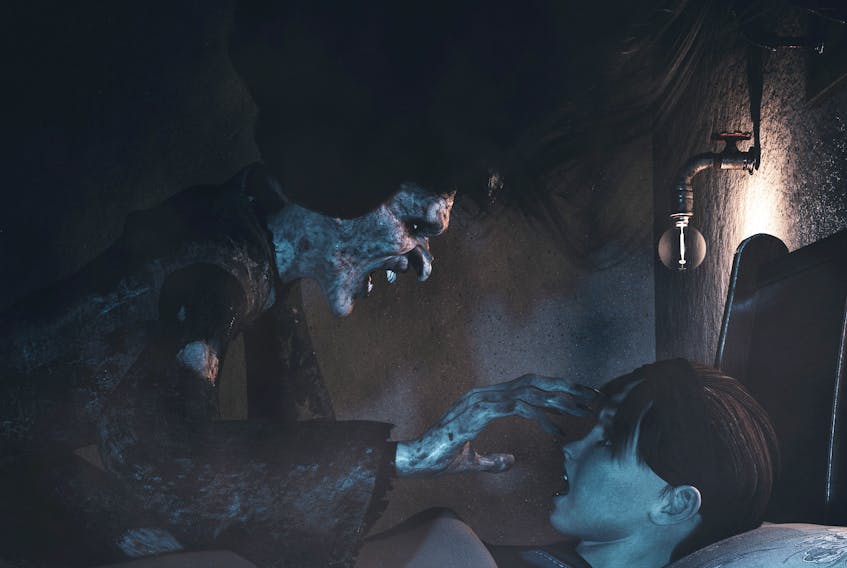ST. JOHN'S, N.L. — To help you better understand what follows, I should tell you about the night I thought I was going to die.
I was sound asleep, cozy and warm under the covers.
Suddenly I was awoken by a shadowy figure that was hunched — almost perched, like a human-sized bird — at the bottom of my bed.
He had long, pointy fingers. Glowing eyes. A crimson mouth with black teeth.
Quickly he jumped from the footboard onto my legs.
I tried to scream for help but I couldn’t make a sound.
The figure was slithering up towards my face and I knew if it got too close it would somehow devour me.
I tried to move, but now it was on my chest and I couldn’t escape.
Again, I cried for help but the most I could muster was a whisper. Over and over I repeated that quiet scream, hoping someone might hear me.
Finally, I jolted upright.
I looked around but the figure had vanished.
I comforted myself with the idea it was a nightmare, but an eerie feeling crept over me.
I clung to my husband and prayed the Old Hag wouldn’t return when I closed my eyes.
This experience is commonly understood in Newfoundland as the Old Hag, but scientists call it sleep paralysis. It exists in cultures all around the world, and some, like Newfoundland, have specific terms and ideas associated with the experience.
In Saint Lucia, for example, it’s described as kokma — attacks by dead spirits or unbaptized babies that jump into a body and squeeze the throat.
Film frenzy
Recently, the Old Hag inspired a group of horror filmmakers in St. John’s called Grind Mind.
John Carter, Justin Wiseman, Francois Van Zyl and Shane Mills share their horror flicks on YouTube.
Currently they’re filming the finale for their Deadflix series, aptly titled ‘Hag’.
On Tuesday, they put out a social media call for Newfoundlanders to share their personal Old Hag experiences for a five-minute documentary to accompany the finale.

Mills called the response to their request “wild”.
“It just blew up, like, my inbox has been going crazy for the past 24 hours, and the experiences range from mild discomfort — not being able to move — to stuff that is literally giving me goosebumps, and some have me worried about how scary our movie is anymore,” he laughed.
Mills said the hundreds of messages the group has received is “amazing horror content.”
“What’s beautiful about it is despite how these things might manifest from a scientific or supernatural perspective, these people believe it. So, the stories are just super chilling because they’re real to them.”
He said the response is too great to ignore, so once the ‘Hag’ finale is released in July — along with a short piece speaking with people about their own Old Hag experiences — the group plans to delve into either a web series or feature-length documentary sharing the Old Hag stories from people across the province.
Hag folklore
Provincial folklorist Dale Jarvis said local Old Hag lore is likely part of an older tradition, but one of the earliest references to it in relation to the province was in the Journal of American Folklore in the 1890s.
Jarvis said there was a short article in the journal about Newfoundland folklore, and it mentioned the Old Hag.
“Clearly the belief was already well in place by the 1890s.”
With the establishment of the Memorial University of Newfoundland Folklore and Language Archive (MUNFLA) in 1968, there now exists plenty of first-hand accounts of the Old Hag, scribbled on cue cards or loose leaf held in filing cabinets and boxes in the archive’s vault.
Many of the experiences also detail ways to rid oneself of the Old Hag.
“My absolute favourite way to cure yourself of the Hag is to take a wooden roofing shingle and to drive a nail through it, and when you go to sleep to lie on your back and place the shingle with the nail pointing straight up, so that if the Hag comes and sits on your chest, she’ll get this nail up her arse,” laughed Jarvis.
“It does sound dangerous, so you have to decide which is worse — sleeping with this nail, or running the risk of getting the Old Hag?”
Jarvis said while people associate images of an old, wrinkly witch-like woman with a hag, the experiences are actually quite varied.

“Some people feel a weight on their chest, some people will see an apparition standing at the foot of their bed, some people will have an auditory hallucination of some kind — they will hear strange noises and be unable to move — so, it really does depend on the person about how they experience the Old Hag.”
Like the Grind Mind crew, Jarvis also enjoys ghost stories and has written several books compiling tales from across the province.
One thing he finds interesting about the Old Hag is that people who would typically scoff at a ghost story will take stories of the Old Hag more seriously.
“I will say, do you know any ghost stories or have you ever had anything supernatural happen to you? And people will say, ‘No, b’y, I don’t believe in ghosts, and I’ve never had anything strange happen to me.’ And then I’ll say, ‘Have you ever had the Old Hag?’
“‘Yes, my son’, and then they’ll launch into this incredibly creepy story about the Old Hag. So, it is one of those experiences that is kind of supernatural, but people don’t see it in quite the same way that they would see things like ghosts or fairies, you know, it is a real experience that people do have, and it kind of blurs the line between the paranormal and the normal.”
Scientific explanation
Dr. Sheila Garland is a clinical psychologist and professor at Memorial University where she is also the lab director at the Sleep, Health, & Wellness Lab.
She said sleep paralysis is normal and occurs in about eight per cent of the general population.
Sleep occurs in stages, but sometimes people fall into or out of what’s called rapid eye movement (REM) sleep too quickly without going through the non-REM sleep stages first.

During REM sleep, people are unable to move major muscle groups. It’s also the stage of sleep known for vivid dreams.
When people fall into or out of REM sleep too quickly, they are aware of being awake but the mechanism that eliminates the ability to move major muscle groups is basically turned on — giving people the feeling that they’re awake but unable to move, which characterizes sleep paralysis.
Garland said people may be able to move fingers or toes or make small sounds but not much more.
“It’s fearful because we have no control, so whenever you take control away from people, to make sense of ‘How come I have no control?’, that’s what’s so scary about it.”
Garland did not comment much on the frightening visuals sleepers experience during sleep paralysis, other than saying that when people experience fear they will try to “make their own understanding of it”.
She said sleep paralysis episodes usually only last about 15 or 20 seconds, though “it feels like forever when you’re in it”, and the episodes are more likely to happen to people who are sleep deprived.
So, while holding a shingle with a nail pointing out might sound interesting, Garland said ensuring you get enough sleep is one of the best ways to prevent sleep paralysis.
“The episodes are usually very quick – they can be very frightening when you don’t understand them, but once you understand, ‘Oh, yea, this is just sleep paralysis’ the fear goes away. So, I think that in terms of what recommendations, it would be education that this is normal, and that you should probably get more sleep.”
Twitter: @juanitamercer









